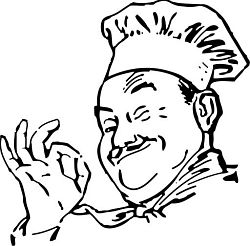 Your mother never taught you this. Her mother never taught her either. The skill has always been passed down through practice and experience. Most people would spend a quarter of their life time preparing, watching and doing it. There had never been any written rules or records of how it is done. There had been no formal cook book or written manual either. Of course we are talking about cooking skills.
Your mother never taught you this. Her mother never taught her either. The skill has always been passed down through practice and experience. Most people would spend a quarter of their life time preparing, watching and doing it. There had never been any written rules or records of how it is done. There had been no formal cook book or written manual either. Of course we are talking about cooking skills.
Sure you can explore and find recipes on websites, journal, books, videos, tapes and many other forms of media that gives you knowledge about what ingredients to use. The fact still remains this cooking skill problem is more complicated than it appears.
You are generally amazed at how it is done. You dream about excelling in this area and receive the admiration from friends. Your great wish to give the husband a superb meal pushes you to find a sure fired method. You strong desire to impress your girlfriend with you cultivated culinary skill receives no second importance. But first thing first, before you become another Gordon Ramsay, you have to know the very simple basics of cooking.
Working in the kitchen is a long tedious job. It is time consuming, hot and sweaty, and sometimes you put your hands into something you might not desire. Before you start cooking, there must be some preparation work to get your food ready. This part of the job usually takes time and it is rough work. If the prep work is made easier, then your life becomes easier. It is natural to learn about food preparation before the venture begins.
We need tools to do our food preparing and having a knife helps in cutting and dividing the food. The knife can help to transform food from a raw to a cooking ready state. So let us start with a knife.
There are a lot of gadgets on the market. There are big ones and there are small ones. There are curly ones and there are colourful ones. There are the ones you do not understand and there are ones that takes an engineer PHD to decipher what they are for. Kitchen gadgets will not make your cooking tastes any better. You do not eat the tool. You eat the food. There are tools and utensils and equipment that makes our job easier and we certainly adapt to them. But the basic is a basic, when all things fail, you can still rely on the simplest of them all: you kitchen knife.
 You start with a knife and the rest of the equipment you will add on when they are needed.
You start with a knife and the rest of the equipment you will add on when they are needed.
The most commonly used knife is the 8” French chef knife. The knife is constructed from the thinnest tip to the thickest heel. The tip is for light nibbling and the heel is to help in a tearing and chopping. The cutting edge is for ordinary daily slicing, dicing, cutting julienne strips and other uses. The back or spine of the knife is for tenderizing meat when needed.
Notice the bolster, when you select a knife, by all means get one with the bolster wrapped up to the handle of the knife. This should prevent bacteria growth when you clean your knife. The rivets should be flat so they do not interfere with your grip.
The most important thing about the knife is the balance. People are all different with their hand strength. Some grip tighter and some are left handed. So you have to find a knife that fits you well and balance well. You use the knife in a rocking motion when you are chopping and slicing and the continuous motion would render your hand tired. That is more reason for you to find a knife that balances well.
Extend your index finger and put the knife on the ridge of the finger by its bolster. A balanced knife should be level. This is not a 100% fool proof but it can give you an idea which side is heavier. By all means you want the blade to be heavier since you work with the blade more and the weight is going to help in slicing by exerting better pressure.
You basically need 3 knives, an 8” French chef knife, a 4” / 5” paring knife and a 9” serrated bread knife. It would be nice to have a knife block where you can put the knives after each use. Putting the knives on the table is poor practice since you can push them, misplace them and cut yourself when they are buried in the mess.
A steel sharpener is also useful. The motion to sharpen a knife is to hold your steel sharpener with the guard upright so it can cover your index finger and your thumb and you slant the knife at an approximate 15 degree angle and PUSH OUT. Finish one side of the your knife and then repeat sharpening the underside.
A pair of scissors or kitchen shearer would help in many areas too. If you are more consciencious about results, you might add a 5” / 6” boning knife. This little collection should allow you to handle 80% of different situations and as they say bon-apetite.
*all knife length described are measurement of the blade, handle is not included.